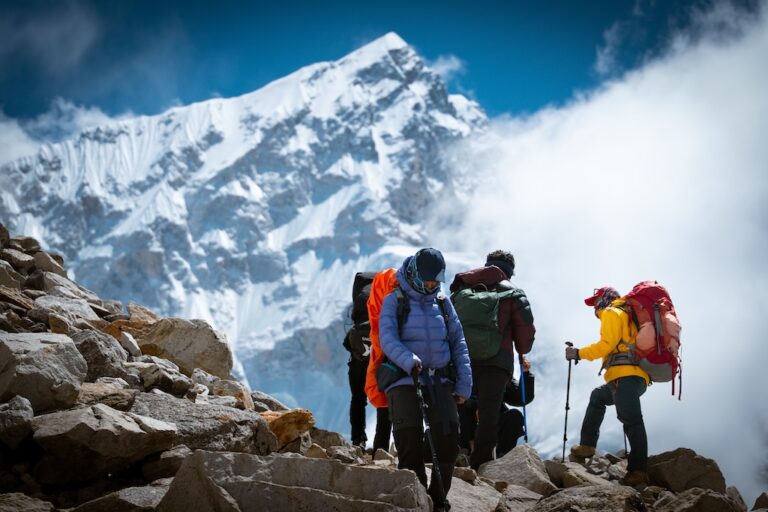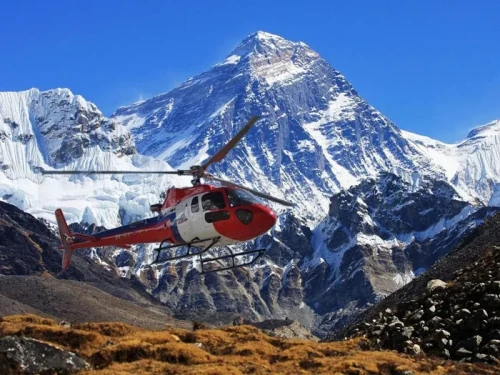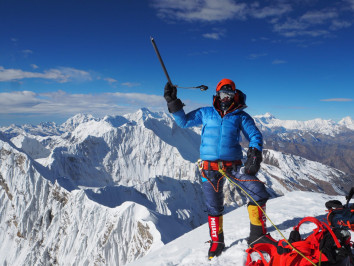High Altitude & Altitude Sickness — Complete Guide

 Kedar Neupane
12th Nov, 2025
Kedar Neupane
12th Nov, 2025
Kedar Neupane
I am Kedar Neupane, a passionate traveler, entrepreneur, mentor, and social contributor, born and raised in a village near the Nepal-China border in Sindhupalchok, Nepal. With a Master’s degree in Business from Tribhuvan University and Level 2 proficiency in the German language, I have dedicated my life to tourism, trade, mentorship, and holistic well-being.
🌍 A Global Explorer with a Vision
Having explored 26+ countries, I have gained profound insights into diverse cultures, business landscapes, and global tourism. My travels have taken me to:
🇹🇭 Thailand | 🇧🇹 Bhutan | 🇲🇾 Malaysia | 🇸🇬 Singapore | 🇨🇳 China | 🇭🇰 Hong Kong | 🇩🇪 Germany | 🇵🇱 Poland | 🇦🇹 Austria | 🇨🇭 Switzerland | 🇭🇺 Hungary | 🇳🇱 Netherlands | 🇧🇪 Belgium | 🇫🇷 France | 🇦🇪 UAE | 🇬🇧 UK | 🇺🇸 USA | 🇹🇷 Turkey | 🇶🇦 Qatar | 🇮🇳 India | 🇮🇩 Indonesia | 🇨🇦 Canada
Through my journeys, I have developed a deep appreciation for cultural exchange, adventure tourism, and sustainable business practices.
🏔️ Entrepreneurial & Professional Journey
I am actively involved in tourism, trade, and mentorship, leading multiple ventures that promote sustainable travel, adventure tourism, and business development:
✔ Founder & MD – Actual Adventure Pvt. Ltd. (A leading adventure travel company in Nepal)
✔ CEO – Himalayas Destination Management Company (Creating premium travel experiences)
✔ MD – Nepal Export & Import Pvt. Ltd. (Promoting Nepalese products globally)
✔ MD – Actual Mentor Pvt. Ltd. (Empowering entrepreneurs and professionals)
✔ Chairman – World Expedition Nepal (Focusing on high-altitude expeditions and trekking)
Through my entrepreneurial journey, social contributions, global explorations, and commitment to lifelong learning, I strive to inspire others to pursue their passions while making a meaningful difference. My dream is to build a world where travel, business, and holistic well-being come together, fostering growth, sustainability, and happiness for all.
Altitude sickness is preventable. Respect the mountains, ascend slowly, hydrate well, and rest when needed. With awareness and preparation, your Himalayan adventure can be both safe and unforgettable.
Table of Contents
High-Altitude Safety Guide: Preventing, Recognizing & Treating AMS, HACE, and HAPE
Exploring the high Himalayas — whether trekking to Everest Base Camp, climbing peaks like Island Peak or Lobuche East, or crossing remote passes brings incredible rewards but also serious risks.
Among these, altitude-related illnesses are the most common and potentially fatal. Every trekker and climber must understand how to prevent, identify, and manage Acute Mountain Sickness (AMS) and its severe forms, High Altitude Cerebral Edema (HACE) and High Altitude Pulmonary Edema (HAPE).
High Altitude & Altitude Sickness — Complete Guide
Traveling to the Himalayas is a dream for many adventurers, but venturing into high altitude regions requires awareness and preparation. The human body needs time to adjust to reduced oxygen levels as elevation increases. Understanding altitude sickness, its prevention, and its treatment can save lives and ensure a safe and enjoyable journey in Nepal’s mountains.
What Is High Altitude?
“High altitude” generally refers to elevations above 2,500 meters (8,200 feet) where oxygen levels begin to drop noticeably.
It can be classified into three levels:
-
High altitude: 2,500 – 3,500 m
-
Very high altitude: 3,500 – 5,500 m
-
Extreme altitude: Above 5,500 m
Popular trekking destinations like Everest Base Camp (5,364m), Annapurna Base Camp (4,130m), and Langtang Valley (3,500m) fall into these zones.
What Is Altitude Sickness?
Altitude sickness or Acute Mountain Sickness (AMS) occurs when your body cannot adapt quickly to low oxygen levels at higher elevations.
Symptoms usually appear within 6 to 24 hours of ascent and include:
-
Headache and dizziness
-
Nausea and vomiting
-
Fatigue or shortness of breath
-
Loss of appetite and sleep disturbance
In severe cases, it may progress to HAPE (High Altitude Pulmonary Edema) or HACE (High Altitude Cerebral Edema), which are life-threatening conditions requiring immediate descent and medical help.
Prevention: How to Avoid Altitude Sickness
-
Ascend Gradually:
Never sleep more than 500m higher per night once above 3,000m. Always take acclimatization days — especially at Namche Bazaar, Dingboche, or Manang. -
Hydrate Well:
Drink 3–4 liters of water daily. Avoid alcohol, caffeine, and smoking, which worsen dehydration. -
Eat Light, Healthy Meals:
Consume carbohydrates, soups, garlic, and ginger tea for energy and better oxygen utilization. -
Take Medication (Diamox):
Diamox (Acetazolamide) can help your body adjust faster. Consult your doctor before taking it. -
Listen to Your Body:
If symptoms worsen, don’t go higher. Rest, or descend to a lower altitude immediately.
Treatment: What To Do If You Get AMS
-
Stop ascending at the first signs of AMS.
-
Descend at least 500–1000 meters if symptoms persist.
-
Rest and take Diamox or Dexamethasone as advised.
-
Oxygen therapy or portable hyperbaric bags can provide relief in remote areas.
Natural & Local Remedies
Nepali guides often recommend garlic soup, ginger tea, and plenty of warm fluids. Garlic improves circulation, while ginger reduces nausea and fatigue. Slow, mindful breathing and yoga-based pranayama (like Anulom Vilom) also strengthen the lungs.
How to Prepare Before High Altitude Trek
-
Train your body with hikes, running, and cycling.
-
Practice breathing exercises (4-7-8 rule).
-
Sleep well and eat iron-rich foods like spinach and beetroot.
-
Always trek with a licensed guide and proper itinerary.
Who is at risk What is AMS? HACE HAPE Prevention Treatment & meds Special considerations Porters Conclusion
Overview
Nepal now hosts over 100,000 trekkers a year. High-altitude travel is increasingly accessible — but altitude illness remains a preventable cause of serious injury and death. Whether you are trekking to Everest Base Camp, visiting high-altitude shrines, working in the mountains, or competing in an event, this guide explains the risks and practical steps to stay safe.
Who is at risk?
Anyone who ascends above roughly 2,500 meters (8,000 ft) can develop altitude illness. Fitness does not guarantee immunity — in fact, very fit people who push themselves may be at higher risk.
- Mountaineers and trekkers
- Pilgrims and tourists visiting high-altitude sites
- Support staff, porters and guides
- Diplomats, miners, skiers and marathon runners at altitude
What is Acute Mountain Sickness (AMS)?
AMS commonly begins with a headache plus one or more symptoms such as nausea, tiredness, dizziness or difficulty sleeping. The underlying cause is reduced oxygen pressure at altitude, which lowers blood oxygen saturation.
“Altitude illness” is an umbrella term that includes AMS and two severe complications: HACE (brain swelling) and HAPE (fluid in the lungs).
High Altitude Cerebral Edema (HACE)
HACE is a life-threatening progression of AMS caused by fluid accumulation in the brain. Symptoms include confusion, loss of coordination, an unsteady gait ("drunk-like" walking) and reduced consciousness.
High Altitude Pulmonary Edema (HAPE)
HAPE causes breathlessness, cough (sometimes with pink or frothy sputum) and low oxygen levels. It can appear independently of AMS and may progress rapidly.
Treatment: Immediate descent, supplemental oxygen when available, and medications such as long-acting nifedipine.
Preventing Altitude Sickness
Altitude illness is largely preventable. Follow these essentials:
1. Slow, conservative ascent
Above ~2,700 m (9,000 ft), do not sleep more than 500 m higher than the previous night. Rest every 2–3 days and plan buffer days in your itinerary.
2. Recognize symptoms early
Watch for excessive fatigue, headache, nausea or poor sleep. Never ignore early warning signs or continue ascending with symptoms.
3. Hydration & diet
Drink ~3 liters of fluids daily and favor a high-carbohydrate diet to support ventilation and energy use.
4. Avoid alcohol & sedatives
These depress breathing and can worsen AMS. Avoid sleeping pills at altitude.
Treatment & Medications
Descent is the most effective treatment. Even a few hundred meters can produce rapid improvement.
Medications commonly used
- Acetazolamide (Diamox): 125–250 mg twice daily for prevention or treatment. Helps speed acclimatization by increasing ventilation. Common side effects: tingling, increased urination, altered taste.
- Dexamethasone: 4 mg every 6–8 hours for HACE emergency treatment. It reduces brain swelling but does not replace descent.
- Nifedipine: 20 mg long-acting every 6 hours for HAPE treatment or prevention in those with past HAPE.
Other tools
Oxygen is highly effective when available. A portable hyperbaric (Gamow) bag can simulate descent by increasing surrounding pressure and buy critical time before evacuation.
Other high-altitude problems & tips
- Periodic breathing: Irregular sleep breathing is common. Diamox before dinner can help; avoid sleeping pills.
- Upper respiratory symptoms: Dry, cold air can cause coughs — cover your face with a scarf and consider an antihistamine at night.
- Peripheral edema: Mild swelling of hands, feet or face is usually benign.
- Fainting (syncope): Often harmless; place the person supine and elevate legs.
Special considerations (medical conditions & groups)
Most people with controlled chronic conditions can travel to high altitude with medical advice:
- Cardiovascular disease: Stable, treated patients may travel—seek clearance and monitor exertion.
- Diabetes: Bring a glucometer and maintain regular checks; insulin needs may change.
- Asthma: Carry inhalers; many asthmatics tolerate altitude well.
- Pregnancy: Avoid sleeping above 3,600 m (12,000 ft).
- Children: Can acclimatize but must be old enough to report symptoms.
- Oral contraceptives: Discuss clotting risk with your clinician and consider alternative methods for high-altitude trips.
Porters & support staff
Porters face the same altitude risks as trekkers. Confirm with your trekking company that porters have suitable clothing, boots, shelter and rest days. Your safety depends on theirs.
How to Avoid Altitude Sickness in Nepal: The Complete Guide for Trekkers and Travelers
Altitude sickness, also known as Acute Mountain Sickness (AMS), is one of the most common challenges faced by travelers exploring the majestic Himalayas of Nepal. Whether you are trekking to Everest Base Camp, hiking to Annapurna Base Camp, or visiting Langtang Valley, understanding how to prevent and manage altitude sickness is vital for your safety and enjoyment.
What is Altitude Sickness?
Altitude sickness occurs when your body cannot get enough oxygen at high altitudes (usually above 2,500 meters). As you ascend higher, the air becomes thinner, and your body struggles to adapt quickly.
There are three levels of altitude-related illness:
-
AMS (Acute Mountain Sickness): Common and mild symptoms like headache, dizziness, and fatigue.
-
HAPE (High-Altitude Pulmonary Edema): Fluid buildup in the lungs — severe and life-threatening.
-
HACE (High-Altitude Cerebral Edema): Fluid in the brain — requires immediate medical evacuation.
How to Avoid Altitude Sickness in Nepal
-
Ascend Gradually:
Never gain more than 500 meters (1,600 ft) of sleeping altitude per day once above 3,000 meters.
Follow the golden rule: “Climb high, sleep low.” -
Take Rest Days:
Include acclimatization days in places like Namche Bazaar (3,440m) or Dingboche (4,410m) on the Everest Base Camp route. -
Stay Hydrated:
Drink 3–4 liters of water daily. Avoid alcohol and caffeine, which dehydrate the body. -
Eat Light and Nutritious Food:
Focus on garlic soup, ginger tea, vegetables, and carbohydrates for energy and better oxygen absorption. -
Use Medication (Diamox):
Many climbers take Diamox (Acetazolamide) to speed up acclimatization. Consult a doctor before use.
What Is the Fastest Way to Cure Altitude Sickness?
The fastest and most effective cure is descending immediately to a lower altitude.
Supplementary steps include:
-
Taking Diamox (125–250mg twice daily)
-
Resting and avoiding exertion
-
Breathing oxygen from portable tanks if available
-
Drinking plenty of fluids
-
Using portable hyperbaric bags (Gamow bags) in severe cases
Is Kathmandu Prone to Altitude Sickness?
No. Kathmandu sits at an altitude of 1,400 meters (4,600 ft), which is well below the altitude sickness risk zone.
However, travelers may feel slight fatigue due to jet lag, pollution, or dehydration — not altitude sickness.
Why Do Mountain Climbers Take Diamox?
Climbers take Diamox to prevent and reduce symptoms of AMS. It works by acidifying the blood, stimulating faster breathing, and increasing oxygen levels.
Most guides and trekkers in Nepal start Diamox one day before ascending above 3,000 meters.
What to Eat to Reduce Altitude Sickness?
A high-carb, low-fat diet helps the body use oxygen efficiently. Ideal foods include:
-
Garlic soup (famous in Namche and Dingboche)
-
Ginger tea and honey lemon tea
-
Lentil soup (dal), rice, and boiled potatoes
-
Fruits and leafy vegetables
-
Avoid heavy meat dishes and alcohol
What Is the Medicine for High Altitude in Nepal?
Common medicines available in Nepal are:
-
Diamox (Acetazolamide) – for prevention
-
Dexamethasone – for severe AMS or HACE
-
Nifedipine – for HAPE
-
Oxygen cylinders and portable oxygen bottles are available in major trekking hubs like Lukla, Namche, and Manang.
Does Drinking Water Help Prevent Altitude Sickness?
Yes! Dehydration worsens altitude symptoms.
Drink 3 to 4 liters per day — plain water, soups, and electrolyte drinks like ORS or hydration tablets are excellent choices.
Why Is Garlic Soup Good for Altitude?
Garlic improves blood circulation and thins the blood slightly, which helps deliver oxygen more effectively. Many Sherpa families and mountain lodges recommend garlic soup as a natural remedy for mild AMS.
What Are the First Signs of Altitude Sickness?
Be alert to these symptoms:
-
Headache
-
Dizziness or light-headedness
-
Shortness of breath
-
Nausea or vomiting
-
Fatigue and loss of appetite
If these worsen, do not ascend further.
How to Prepare Your Body for High Altitude?
Start training at least 4–6 weeks before your trek:
-
Cardiovascular exercises: running, hiking, cycling
-
Strength training for legs and core
-
Breathing exercises (pranayama, deep breathing)
-
Simulate altitude training if possible (using a stair mask or high-altitude gym)
At What Height Do You Start to Get Altitude Sickness?
Symptoms generally appear above 2,500 meters (8,200 ft) — common along routes like:
-
Namche Bazaar (3,440m) – mild AMS risk
-
Dingboche (4,410m) – moderate risk
-
Lobuche (4,910m) and Gorakshep (5,164m) – high risk
Is Kathmandu Considered High Altitude?
No. Kathmandu (1,400m) is at a moderate elevation, far below the danger zone. Most people experience no altitude issues here.
What Is the Best Drink for High Altitude?
-
Warm water with lemon
-
Garlic soup or ginger tea
-
Electrolyte drinks (ORS)
-
Coconut water (natural hydration)
Avoid alcohol, coffee, and sugary sodas.
Who Is Most Prone to Altitude Sickness?
Anyone can suffer from AMS, regardless of fitness.
Higher risk groups include:
-
Fast climbers who don’t acclimatize
-
Smokers and heavy drinkers
-
People with lung or heart problems
-
Young and middle-aged adults (who push too hard)
How to Prepare Lungs for High Altitude?
-
Practice deep breathing exercises daily
-
Improve lung capacity through swimming, hiking, or cycling
-
Practice 4-7-8 breathing rule
-
Inhale for 4 seconds
-
Hold for 7 seconds
-
Exhale for 8 seconds
This technique calms your breathing and enhances oxygen exchange.
-
Which Pranayama Is Best for High Altitude?
Anulom Vilom (Alternate Nostril Breathing) and Bhastrika (Bellows Breath) are excellent for strengthening lungs and increasing oxygen efficiency naturally.
What Is the Best Home Remedy for Altitude Sickness?
-
Garlic soup
-
Ginger tea
-
Hydration with lemon water
-
Rest and slow ascent
-
Oxygen inhalation if necessary
Does Taking Iron Help with Altitude Sickness?
Iron helps your body produce more red blood cells, which transport oxygen. However, don’t take iron supplements unless prescribed, as excess iron can cause nausea and stomach issues.
How to Avoid Getting Sick in Kathmandu?
-
Drink only bottled or filtered water
-
Avoid raw salads or street food
-
Wear a mask during high dust or pollution days
-
Rest on your first day to recover from flight fatigue
How to Train Yourself for Altitude Sickness?
-
Go on short hikes above 2,000 meters before your main trek
-
Sleep one night higher and return to lower altitude
-
Gradually expose your body to altitude over multiple trips
How to Control Blood Pressure at High Altitude?
-
Take blood pressure medicines regularly if prescribed
-
Avoid caffeine and alcohol
-
Rest adequately and avoid overexertion
-
Stay hydrated and warm
Why Does Coca Tea Help with Altitude?
Coca tea (popular in South America) contains natural alkaloids that stimulate oxygen uptake and reduce headache or fatigue. While not native to Nepal, ginger and garlic tea are effective local alternatives.
What Worsens Altitude Sickness?
-
Rapid ascent without rest
-
Dehydration
-
Alcohol or sleeping pills
-
Ignoring early symptoms
-
Overexertion
How Do You Prepare Your Lungs for High-Altitude Mountains?
-
Regular cardio and hiking practice
-
Breathing exercises (yoga or 4-7-8 rule)
-
Avoid smoking or pollution exposure before trekking
-
Use oxygen-enriching foods: spinach, beetroot, apples, and garlic
How to Prevent Altitude Sickness While Trekking in Nepal
Although trekking in Nepal is generally safe and enjoyable, altitude sickness (also known as Acute Mountain Sickness or AMS) is one of the most common health concerns for travelers visiting high-altitude regions such as Everest, Annapurna, Langtang, and Manaslu. Even healthy and fit trekkers may experience mild symptoms when ascending too quickly or ignoring proper acclimatization. Therefore, understanding how to prevent altitude sickness while trekking in Nepal is essential for a safe and successful adventure.
Tips to Prevent Altitude Sickness in Nepal
- Ascend Slowly: After reaching 3,000 meters, it’s vital to gain altitude gradually. For every 1,000 meters of elevation gained, rest for an extra night to allow your body to adjust. If you experience discomfort, descend about 300–400 meters to sleep at a lower altitude.
- Stay Hydrated: Drink plenty of fluids such as water, soups, and herbal teas. Avoid dehydration, which worsens altitude symptoms. However, do not overhydrate to the point of discomfort.
- Eat Carbohydrate-Rich Foods: Your body needs more energy at high altitudes. Include extra carbohydrates like rice, potatoes, pasta, and bread to maintain your stamina during the trek.
- Climb High, Sleep Low: Even if you hike to a higher altitude during the day, descend 300–400 meters to sleep. This helps your body adapt without overstraining your system.
- Avoid Alcohol, Smoking, and Sleeping Pills: These substances can reduce your breathing rate and oxygen absorption, making acclimatization more difficult.
- Don’t Overexert Yourself: Avoid heavy exercises at high altitudes. Walk at a steady, comfortable pace and listen to your body’s signals.
- Never Trek Alone: Always trek with a licensed guide or a trusted companion. Inform them immediately if you experience any unusual symptoms such as headache, dizziness, or shortness of breath.
- Use Medication if Needed: Acetazolamide (Diamox) 250 mg twice daily can help prevent altitude sickness. Consult your doctor before taking any medication.
- Follow the 1,000 m Rule: Do not ascend more than 1,000 meters in one day once above 3,000 m elevation.
- Seek Medical Help Immediately: If symptoms worsen or do not improve with rest, descend to a lower altitude and call for rescue support.
Importance of Acclimatization During Treks in Nepal
Acclimatization is one of the most important parts of high-altitude trekking in Nepal. It refers to spending extra time at a specific altitude so your body can adapt to the reduced oxygen levels. As you climb higher, the air becomes thinner and oxygen molecules are spaced farther apart. This reduces air pressure and affects your body’s oxygen intake.
During acclimatization, your body undergoes several natural adjustments — your breathing rate increases, your body produces more red blood cells to carry oxygen, and your lungs expand their capacity. These processes require time. Therefore, acclimatization days are built into most trekking itineraries, such as in Namche Bazaar (3,440 m) and Dingboche (4,410 m) on the Everest Base Camp Trek.
Everyone reacts differently to altitude depending on factors such as age, fitness, and experience. While Sherpas and high-altitude natives are naturally adapted to lower oxygen levels, first-time trekkers need more rest days and careful pacing.
Why Fast Ascents Are Dangerous
Rapid ascents are one of the leading causes of altitude sickness. Moving too quickly prevents your body from adjusting to lower oxygen levels, which can cause headaches, nausea, fatigue, or more serious conditions such as HACE (High Altitude Cerebral Edema) or HAPE (High Altitude Pulmonary Edema). Trekking slowly, taking acclimatization breaks, and following a proper itinerary are key to staying safe.
Frequently Asked Questions About Altitude Sickness in Nepal
1. What Causes Altitude Sickness?
The main cause of altitude sickness is ascending to high altitudes too quickly. As elevation increases, the amount of oxygen in the air decreases, and your body needs time to adapt. If this adjustment period is skipped, you may experience symptoms like headache, nausea, or dizziness.
2. What Does High Altitude Do to Your Body?
At higher altitudes, your breathing rate increases as your body tries to absorb more oxygen. Over time, your lungs expand, and your blood produces more red blood cells to carry oxygen. However, without proper acclimatization, your body cannot adjust effectively, leading to AMS symptoms.
3. Am I Likely to Get Altitude Sickness on the Everest Base Camp Trek?
Yes. Altitude sickness can begin as low as 2,750 meters, and the Everest Base Camp Trek starts at Lukla (2,860 m). Most itineraries include acclimatization days at Namche Bazaar (3,440 m) and Dingboche (4,410 m) to help trekkers adjust. Skipping these rest days increases the risk of AMS.
4. What Treks in Nepal Have the Highest Risk of Altitude Sickness?
High-altitude trekking routes above 4,000 m are most likely to trigger AMS. These include:
- Everest Base Camp Trek & Everest Three Passes Trek
- Gokyo Lake Trek
- Manaslu Circuit Trek
- Dhaulagiri Base Camp Trek
- Nar Phu Valley Trek
- Upper Dolpo Trek
- Annapurna Circuit & Annapurna Base Camp Trek
- Kanchenjunga Base Camp Trek
All of these routes require gradual ascent and rest days to stay safe. Licensed guides from reputed companies like Actual Adventure or Heaven Himalaya are trained to recognize and manage altitude sickness symptoms during the journey.
5. Can Healthy People Get Altitude Sickness?
Yes. Even if you are fit and healthy, if you have not acclimatized properly or climbed too quickly, you can experience altitude sickness. Fitness helps with endurance, but it does not guarantee immunity from AMS.
6. Is It Hard to Breathe at High Altitudes?
Yes, shortness of breath is one of the primary symptoms of altitude sickness. If you experience difficulty breathing, stop, rest, and descend if needed. Always inform your trekking guide immediately.
7. Can I Prevent Altitude Sickness Naturally?
Yes, you can reduce your risk naturally by trekking slowly, drinking plenty of water, eating enough carbohydrates, taking acclimatization days, and avoiding alcohol and smoking. These simple habits help your body adjust to high altitudes without relying solely on medication.
Final Advice
Altitude sickness can affect anyone, but it is entirely preventable with proper planning and awareness. Take your time, follow a gradual ascent, and never ignore early symptoms. Remember, reaching your destination is rewarding, but returning safely is the real success. With careful acclimatization and a professional trekking guide, you can enjoy every breathtaking moment of the Himalayas in Nepal without risking your health.
Final Thoughts: Trek High, Trek Smart
Altitude sickness is preventable if you trek smartly.
The key is to ascend gradually, stay hydrated, rest when needed, and listen to your body.
Thousands of trekkers safely complete high-altitude treks in Nepal every year with proper preparation, guidance, and awareness.
If you’re planning your next adventure to the Himalayas, choose a professional trekking company like Actual Adventure Pvt. Ltd. for expert-guided itineraries, medical support, and safe acclimatization plans.
Conclusion
High-altitude travel is immensely rewarding when approached with patience and respect for the environment and your own physiology. Most altitude illnesses are preventable. Plan conservative itineraries, watch for symptoms, and prioritize descent and treatment when needed. The mountains will wait — trek wisely and return home safely.
Prepared for trekkers and expedition teams — adapt and reuse for company blogs, client briefings, or printed leaflets. For customization or SEO optimization, contact your content team.
© Actual Adventure / Kedar Neupane Author
Travel Expert & Founder, Actual Adventure Pvt. Ltd.
www.actual-adventure.com | Explore. Experience. Elevate.
Recent Posts

18th Nov, 2025

14th Nov, 2025

12th Nov, 2025

28th Oct, 2025

19th Oct, 2025

18th Oct, 2025

14th Oct, 2025

14th Oct, 2025

















